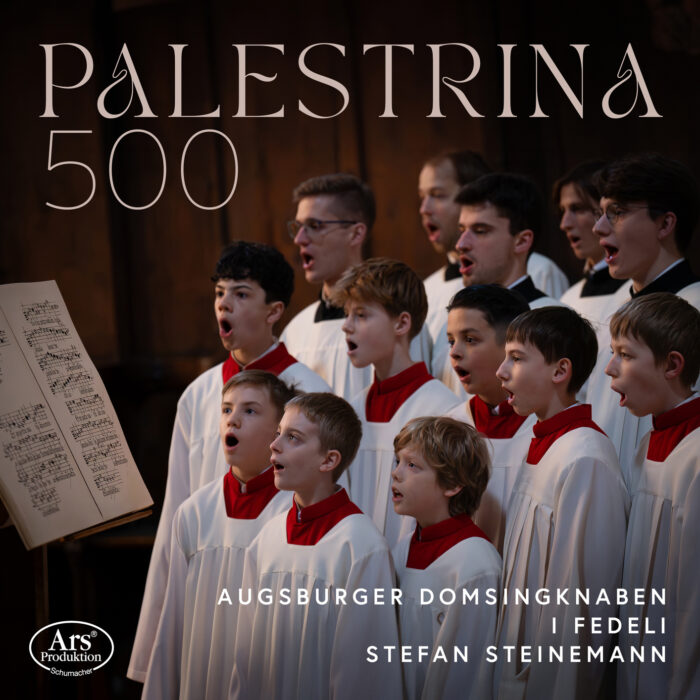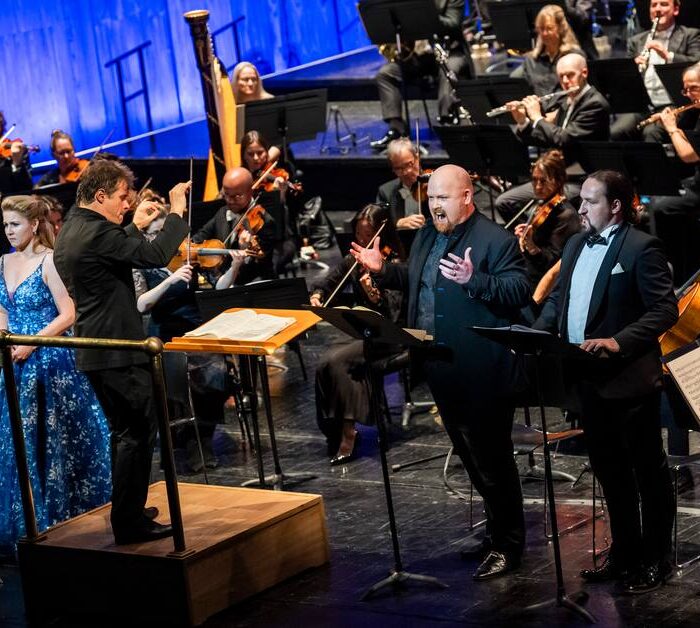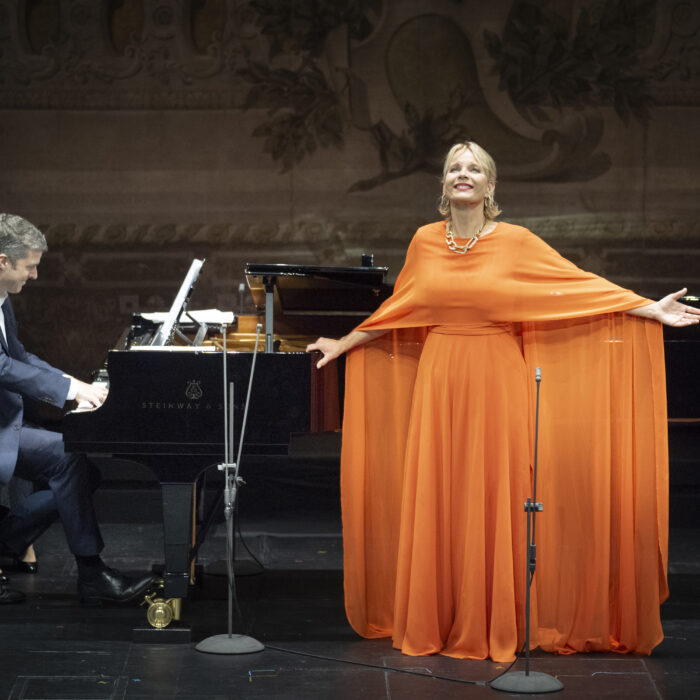
CD Review: Tudor Queens
A Poignant Portrait of Donizetti’s Three Queens Led by a Magnificent Diana Damrau
By Francisco SalazarMany times the final moments of a piece of art are the ones that leave the audience with the biggest impression. It may be the final image of a film or the final bars of a musical work.
In the bel canto repertoire, the final impression is generally left by whether a singer hits a certain high note, be it an E flat or D or a C. Generally these are the climactic moments of the work, and they are expected by tradition. However, they were generally never written by the composer, and to judge performances on whether or not the performer hit the note is in bad taste. But if the performer does attempt the note and fails, the presentation will also always be judged on the note. That has happened in many performances that this reviewer has been to.
In listening to Diana Damrau’s new album, one has to wonder who decided to add the final Ds in both the finales of “Maria Stuarda” and Roberto Devereux.” Did Warner Classics or the engineers not trust Damrau’s expressive voice or Donizetti’s music? Did Sir Antonio Pappano and Damrau decide it would be important to add the final notes in another take? Who in the editing room had final cut and decided that this was the best way to end both scenes?
Ultimately, whoever had the final say has done a disservice to both Damrau and Pappano’s incredible work in the rest of the album. What the audience is left with at the end of both these scenes are spliced-in High Ds that either sound like they were taken from an older Damrau recording, autotuned, or just recorded at the end of each session and placed in without a thought of what these notes actually mean to the entire piece. Donizetti’s scores are more than one note and in following these traditions, Warner Classics has once again played into the tried and tired approaches of the bel canto repertoire.
The Tudor queens are among the most dramatic and masterful works in the bel canto repertoire. No High note can replace the intricacies or subtleties in Donizetti’s music and Damrau has a clear understanding of this in her overall interpretation of the three scenes recorded on this new album.
Anna Bolena
The album opens with Anna Bolena’s mad scene. Unlike most CDs, Damrau and Pappano have decided to include the opening chorus “Chi può vederla.” Pappano opens the nostalgic and melancholic piece with thunderous chords foreshadowing the impending doom of Anna and drives the tempo forward using distinctive accents and taking advantage of the crescendoes and decrescendos that are written in Donizetti’s score. The women’s chorus sings with a dark hue that emphasizes the melancholic mood of the piece and follows Pappano’s dynamic shifts.
It sets up the overall mood and tone of the scene and leads into the “Piangete voi?” organically, which Pappano opens with long and smooth phrasing. In Damrau’s first lines, she sings with a soft and gentle timbre emphasizing Bolena’s fragile state. And throughout the opening phrasings, one can hear the thin and breathy qualities of her voice that bring a delicacy to the scene.
Then as the flute solo enters, Damrau sings the “Oh! chi si duole?” as if weeping. She extends the line with a gorgeous legato cutting it off as she decrescendos. But then suddenly, in the next interlude “Chi parlò di Percy? … Ch’io non lo vegga,” Damrau’s tone shifts into disarray with the orchestra accompanying with more frenetic syncopations that Pappano emphasizes with distinct accents in the percussion and building on the dynamics.
It’s a powerful synergy of music-making as both the orchestra and Damrau’s voice build on the following “Ch’io m’asconda a’ suoi sguardi. – È vano – Ei viene …Ei m’accusa … ei mi sgrida. Oh! mi perdona …” only for the soprano’s voice to finally arrive at a potent forte, showcasing Bolena’s anger, madness, and desperation. Damrau repeats the word “Perdona” two times, forte the first time before she beautifully repeats the word decrescendoing back to a fragile pianissimo.
That desperate quality returns once more in “Tu sorridi? … oh gioia! …Non fia, non fia che qui deserta io moia!” as Damrau delivers shorter phrases and more accented and staccato lines. She even decides to go up the octave in “Oh Gioa!” emphasizing the instability in her character.
The “Al dolce guidami” opens with an oboe solo that expresses the nostalgic feeling of the aria. The soprano then takes over the legato line and in this recording with Damrau follows the oboe’s part, creating a duet-like effect. Throughout the aria, Damrau indulges in stretching the line almost as if she wants to hold onto it forever. Her facility in going from piano to fortes is also of note as it creates an expressive quality of yearning and weeping. Her trills on the “Al queto rio” and “Che i nostri mormora” are well controlled while her ascensions in the slow coloratura lines like “Sospiri ancor” are virtuosic as she takes the initial piano line and slowly ascends to a crescendo before starting the next phrase. In the cadenza, Damrau sings with delicacy and fluid roulades ascending in the higher tessitura with ease and singing with a vibrant timbre.
As she descends to the lower reaches of the voice to end the aria, the orchestra fluidly moves to the next recitative, where Damrau’s timbre once again turns from bright and yearning to one of distress. Damrau effectively shifts that delirious moment to one of anguish in the lines “Oh! in quale istante Del mio delirio mi riscuoti, o Cielo! A che mai mi riscuoti? …” with shorter phrases and brings her voice to its capacity as she ascends to a forte on “Ah!”
In her following prayer, “Cielo, a’miei lunghi spasimi,” Damrau takes each line with an immaculate mezzo voce. As she ascends to the higher reaches of the voice, she holds on to the soft dynamic. It may be a short and brief segment but the soprano brings a gleaming color to each moment and is nicely accompanied by the Sara Rocchi, Domenico Pellicola, and Saverio Fioremezzo, which give nice support to the musical reading.
The moment of bliss is interrupted by celebratory music, which in the hands of Pappano sounds march-like and rigid and less circus-like. Damrau’s voice garners a more agitated tone at this moment as the music also grows in dynamics and dramatic force. Damrau chooses to interpolate up for the final “cessate,” which while a bit wobbly, creates the right emotion and fury. In her final declamation “Manca, ahi! manca a compire il delitto D’Anna il sangue, e versato sarà,” Damrau chooses for a grittier timbre that exposes the lower parts of her voice. However, as Damrau descends into the chest voice, the sound becomes a bit hollow and lacks the resonance for the final phrase on “sarà.”
After a compelling and musically rich scene, Damrau struggles on the final “Coppia Iniqua.” Her command of the text is unique as she emphasizes each word and one can understand the anger and fear in her Anna Bolena through the words themselves. However, her quality is compromised throughout and the vocal power that is necessary for this final declamation never arrives.
Damrau’s voice thins out from the beginning of the cabaletta and when she descends down to her lower chest voice on the text “Iniqua” and “Vendetta” in the first repeat, the voice loses its resonance and takes on an airy quality. As she ascends from the bottom of the voice in the following phrases, “Non impreco in quest’ora tremenda,” Damrau’s voice takes on a wobbly sound that loses the gleam in her lyric soprano. The trills in “Scenda” are clear and quite accurate and on the phrases “Ei m’acquisti clemenza e favore,” rather than singing it with a forte, here Damrau gives it a lighter dynamic that allows the voice some flexibility. This moment allows Damrau to show a more fearful Bolena, rather than the usual anger.
However, once Damrau is forced to ascend to the higher range of her voice on “Favore” and “pietà,” the voice once again loses color and beauty and instead takes on an arid sound. On the second repeat Damrau interpolates a number of high notes and from the first phrases “Coppia Iniqua,” her voice sounds underpowered. Her coloratura roulades are sung with accuracy and virtuosic prowess but the voice on each ascension obtains an unpleasant wobble. During the coda, as the chorus comes in and the orchestra’s power is in full display, it is clear that Damrau struggles to sing over it as her wobble is a bit more open.
From a mixing point of view, the engineer does no favors to Damrau as her voice is barely heard over the massive ensemble. The climactic final note for Damrau here is a struggle as the voice clearly has no power left and instead, she relies on the wobble to get through the final moments. Meanwhile, Pappano does his best to keep the tempo moving and driving Donizetti’s dramatic orchestration forward.
Maria Stuarda
To date, Maria Stuarda is the only Tudor queen Damrau has performed on stage, and with this recording, she proves to have great command of every detail in the scene.
In “Anna…Qui più sommessi,” Damrau’s first lines, “Io vi rivedo alfin” are expressed with a yearning mezza voce. There is also great calm to the voice that you can hear throughout this opening recitative that contrasts with the other two scenes. Even as she repeats “l’estrema prece alziam devota e ardente,” you can hear the voice glimmering with hope.
That leads into the preghiera, “Deh! Tu di un’umile preghiera il suono” where Damrau leads with a mezzo forte and that same glow. In many ways, there is an ethereal and angelic feel to the quality of the voice as she sings each phrase. Even as the chorus sings with a much more distraught feel, Damrau’s small interludes “Ah! sì … Dio!” and “Ah!” are filled with confidence and resolution. When Damrau joins the chorus, the voice becomes one with the ensemble and strengthens with each crescendo.
One of the most astonishing moments in the entire preghiera is how Damrau holds her “Ah!” for 20 seconds all while the chorus sings the melodic line “Tolta al dolore, tolta agli affanni.” Damrau sustains the line through their phrase and crescendoes and decrescendos into the next melodies. As the prayer arrives at its climax, Damrau’s voice obtains greater power and she sings with greater force and resolution. It is almost as if the soprano’s Maria Stuarda has already come to terms with her fate.
In her following aria “D’un cor che muore reca il perdono” the soprano begins with shorter and accented phrases almost as if declaiming rather than singing her hopes for Britain. In her phrases “Ah! dal rimorso non sia punita; tutto col sangue cancellerò. Ah! d’un cor che muore reca il perdon” the phrases begin to obtain a stronger legato line and Damrau interpolates into her higher range almost as if she was imploring that the fate her character would end all the hate and blood spilled on the royal lands. As she gets to the cadenza-like ending of the aria, the voice obtains that same angelic-like tone that sings with easiness, providing a glimpse of hope. The chorus’ accompaniment adds to that quality singing with a light piano.
Damrau’s Maria releases her character’s suffering in the following interlude as Domenico Pellicola’s Roberto sings his small but crucial solo “Ah! che non posso lasciarti ancora” with a desperate quality. His final “vile” is sung forte as a final act of defiance. Damrau follows that with “Roberto, Ascolta,” which begins with a commanding forte and slowly decrescendos, holding the “Ascolto” into the final cabaletta.
The flute solo begins with a nostalgic quality that leads into “Ah! se un giorno da queste ritorte” where Damrau sings with a comforting tone that at the same time expresses that sense of nostalgia and pain. That comfort eventually evolves into a sense of desperation as she repeats the text “il flagello d’un Dio punitor” singing each repetition with drive. Right before the repeat, “Anna, addio! Roberto, addio!,” the voice takes on a more delicate tone and there is a sense of hesitation in the way it shimmers with the text.
The opening of the repeat “Ah! se un giorno,” Damrau begins the “Ah!” with slight piano and crescendoes into the phrase with a much more mournful tone. She sings with quieter phrases but when she interpolates high notes in phrases like “da forte per estremo conforto d’amor” the sound obtains a much more desperate and frantic quality. There is a rawness in the voice.
The same could be heard in “non richiami sulI’Anglia spergiura il flagello d’un Dio punitor” with Damrau singing with a fortissimo vigor, almost as if she were weeping. On the repeat of “d’un Dio punitor” Damrau begins with a softer timbre only to once again drive the music forward and bring her voice to her greatest extremes. In the coda, that same drive is present as she is accompanied by the frenzied orchestra and tense chorus. Here, her voice takes on the raw grit leading into her final lines. It is breathtaking and sublime rendition except for the already mentioned high note.
It is important to mention that Pappano and the chorus are also great partners to Damrau in this scene, bringing out a number of nuisances to the orchestration. But the highlight is the opening chorus. The opening bars of the scene “Vedeste, vedemmo,” open with the brass fanfare giving it a dark and nostalgic mood followed by the rolling percussion that brings the orchestra to a march-like rhythm. Here Pappano allows each soloist to give their take on the central melody, from the winds to the solo cellist to the strings. Meanwhile, the string accompaniment builds each time with the phrases becoming a bit more accented and disconnected. That builds the orchestra to a crescendo and eventually leads into the choral section and repetition by the chorus. The male chorus starts with a piano and then continues to crescendo alongside the orchestra. Pappano is also able to get a contrasting feel between the female and male chorus. While the male singers sound a bit more formal, there is greater urgency to the female chorus. It is only when the two sing together that you can sense the great sentimental qualities and the tragic mood of what is to come.
Roberto Devereux
The album ends with the final Tudor queen. The scene begins rather obtrusively with Pappano overdoing it with the accents on the chords but eventually calming the orchestra to a more legato color. Still the chords that lead into Elisabetta’s entrance play a bit over the top with unnecessarily bombast. In Damrau’s initial recitative, “E Sara in questi orribili momenti,” the soprano gives each line a beautiful tone with an even legato. The legato continues until the lines “Pur … fugge il tempo! …Vorrei fermar gl’istanti,” where Damrau sings with a breathy tone that emphasizes Elizabeth’s anger and insanity. The soprano continues crescendoing until arriving at the phrase “Arresta” where the voice blooms with a gorgeous silver tone. That moment leads into “Vivi ingrato.”
Here Damrau sings each phrase with a slight accent and shapes the piece as a lament. One can hear every consonant and vowel giving clarity to every word. That allows the listener to be drawn into this queen’s nostalgia. Damrau herself relishes every legato line, holding each note as long as she can and adding contrast between her bright upper tessitura and duskier chest voice. The repetition of the phrases “m’abbandona In eterno a sospirar” adds increased urgency until the cadenza where Damrau sings with flexibility; here her upper range shines with bright colors all while maintaining the sentimentality of the piece. Pappano also works beautifully with Damrau as he gives the piece a more flexible tempo. The flute solo is also commendable as it sets the tone of nostalgia that Damrau then takes over.
A sense of urgency immediately continues throughout the scene as Sara, portrayed here by Irida Dragoti, enters. Pappano’s attention to rhythm in the string section adds a sense of chaos as Sara reveals she is Elisabetta’s rival and that she has betrayed her. Dragoti herself uses her weighty mezzo to drive that sense of instability. The orchestra’s dynamics continue to grow in the scene eventually arriving at a fortissimo that signals the death of Roberto. That leads to Damrau’s phrasing changing as she digs into the text with a gritty tone and with accented rolling Rs on “Tu, perversa.” Her accented phrases are then copied by the orchestra, further accentuating Elisabetta’s anger. As the recitative ends Damrau digs into her lower reaches, giving resonance to the bottom of the voice. She is followed by Pappano’s orchestra as it decrescendos with the strings, giving a menacing quality that opens “Quel sangue versato.”
Unlike many sopranos who open this cabaletta with anger and pronounced accents, Damrau opens the “Quel sangue versato” with smooth legato phrases that emphasize Elisabetta’s sadness and pain. As she rises in her “riclama vendetta,” there is an agonizing tone in her high notes and her forte phrases. And while the voice continually grows throughout the first half of the cabaletta, Damrau also gives moments of intimacy in her declamation, particularly in the phrases “Nell’ultimo istante Volgetevi a Dio; Ei solo perdono conceder potrà.” Here she sings with a more airy tone that emphasizes a queen losing all power and control.
Damrau declaims “Tacete! Non regno, non vivo …Uscite!” with fear and hesitancy, leading into the second portion of the cabaletta. Donizetti famously wrote new text for the second part, which allows the singer to get deeper into Elisabetta’s mind. Damrau attacks the phrases with more vigor and more accented lines that once again emphasize the rolling Rs in “percorre la reggia.” The airy quality is sustained throughout and one can hear that the soprano is taking more risks with her fortes as she lets out her full voice bloom on such lines as “troncato …Di gemiti” and “schiusa per me.” Her coloratura line is also impeccable as she moves towards the coda with great flexibility. Unlike the final lines in “Anna Bolena,” where Damrau’s voice couldn’t cope with the chorus, here she gets through clearly. With the exception of the lamentably stitched high D, the orchestra drives the ending with such dramatic weight that one just wants to relisten immediately.
If there is anything from this scene that is missing it is a visual component. Damrau is a stage animal and as I was listening to the Devereux scene, I could not stop thinking of what Damrau would be like performing this final scene on stage.
Overall the album is an artistic achievement even if not perfect. It showcases Damrau’s expertise in the way music and text should be integrated through another successful collaboration between Pappano and the soprano.



